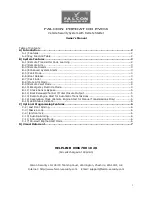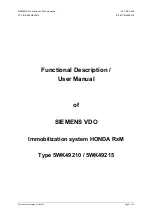
FIGURE 1
FIGURE 2
FAMILY ROOM
DINING ROOM
KITCHEN
BEDROOM
BEDROOM
BEDROOM
LIVING ROOM
DENOTES SMOKE ALARM
WITH FALSE ALARM CONTROL
DENOTES SMOKE ALARM
KITCHEN
DINING
ROOM
BEDROOM
BEDROOM
BEDROOM
LIVING ROOM
FOR EXAMPLE:
A. A SMOKE ALARM MAY NOT SENSE A FIRE ON ANOTHER LEVEL OF A
RESIDENCE OR BUILDING. A second-floor smoke alarm may not detect
a fire on the first floor or in the basement of a building. Therefore, smoke
alarms must be installed on every floor or level of your home or building.
B. IF THE SMOKE ALARM IS LOCATED ON A DIFFERENT LEVEL THAN
THE BEDROOMS, OR IN AN ISOLATED AREA OF THE HOUSE OR
RESIDENCE, IT IS LESS LIKELY TO WAKE UP PEOPLE SLEEPING IN
THE BEDROOMS.
ALL TYPES OF SMOKE ALARMS HAVE LIMITATIONS. NO TYPE OF SMOKE ALARM
CAN SENSE EVERY KIND OF FIRE OR SMOKE EVERY TIME.
Ionization smoke alarms are your best overall choice for reliability and
fast response time (NFP Research Foundation and U.S. Fire
Administration Data) since they quickly sense small invisible smoke
particles and also sense large visible smoke particles. Note,
photoelectric smoke alarms may respond faster in certain types of fires,
for example slow smoldering fires with large visible smoke particles. For
additional protection the NFPA recommends the use of multiple smoke
alarms and heat detectors.
You should use both battery-powered and direct-wired 120-volt AC-
powered smoke alarms. Since A SMOKE ALARM WILL NOT WORK
WITHOUT POWER, having alarms that will work from two different power
sources can give you extra protection in case of a dead battery, or an AC
power failure.
Using a smoke alarm in a smoky area like a kitchen, or in a high humidity
area near a shower, can cause false alarms. DO NOT TAKE THE ALARM
DOWN. DO NOT SHUT OFF THE POWER TO THE ALARM. IF YOU HAVE A
FALSE ALARM, TRY WAVING A TOWEL NEAR THE ALARM TO CLEAR
THE SENSING CHAMBER. A SMOKE ALARM WILL NOT HELP PROTECT
YOU IF IT IS NOT POWERED OR THE UNIT IS REMOVED. An alarm with a
FALSE ALARM CONTROL feature should be used (where allowed by state
and local codes) to minimize these nuisance alarms.
A SMOKE ALARM MAY NOT ALWAYS WARN YOU ABOUT FIRES CAUSED
BY CARELESSNESS OR SAFETY HAZARDS SUCH AS SMOKING IN BED,
VIOLENT EXPLOSIONS, ESCAPING GAS, IMPROPER STORAGE OF
FLAMMABLE MATERIALS, OVERLOADED ELECTRICAL CIRCUITS,
NATURAL CAUSES SUCH AS LIGHTNING, CHILDREN PLAYING WITH
MATCHES, AND ARSON. Fire prevention is your best safeguard.
Installing smoke alarms may make you eligible for lower insurance rates,
but SMOKE ALARMS ARE NOT A SUBSTITUTE FOR INSURANCE. Home-
owners and renters alike should continue to insure their lives and properties.
WHERE YOU SHOULD INSTALL YOUR SMOKE ALARMS
The National Fire Protection Association’s (NFPA) Standard 72, Section 2-2
provides information regarding the smoke detection equipment required
within the family unit.
Section 2-2.1.1.1 reads as follows:
“Smoke detectors shall be installed outside of each separate sleeping
area in the immediate vicinity of the bedrooms and on each additional
story of the family living unit including basements and excluding crawl
spaces, and unfinished attics. In new construction, a smoke detector shall
be installed in each sleeping room.”
Section A-2.5.2.1 Smoke Detection - Are More Smoke Detectors
Desirable? reads as follows:
“ The required number of smoke detectors might not provide reliable early
warning protection for those areas separated by a door from the areas
protected by the required smoke detectors. For this reason it is
recommended that the householder consider the use of additional smoke
detectors for those areas for increased protection. The additional areas
include the basement, bedrooms, dining room, furnace room, utility room,
and hallways not protected by the required smoke detectors. The
installation of smoke detectors in kitchens, attics (finished or unfinished),
or garages is not normally recommended, as these locations occasionally
experience conditions that can result in improper operation.”
This equipment should be installed in accordance with the National Fire
Protection Association’s Standard 72, NFPA, Batterymarch Park, Quincy,
MA 02269.
THIS STANDARD MEANS YOU SHOULD INSTALL AND USE A SMOKE
ALARM IN EVERY ROOM AND AREA OF YOUR HOUSEHOLD OR BUILDING
FOR BEST PROTECTION.
THE FOLLOWING INFORMATION WILL HELP YOU SAFELY PLACE YOUR SMOKE ALARMS:
• Do install your smoke alarms in accordance with all applicable laws,
regulations, standards and codes.
• Do install a smoke alarm in the hallway outside every bedroom area.
If the bedroom has a door, there must be a smoke alarm inside and
outside the bedroom. See Figure 1. If your home or residence has
two bedroom areas, a smoke alarm must be placed outside the
second bedroom area, and inside the bedroom(s) if they have doors.
See Figure 2.
2
110-1009D Engl 1/11/07 10:59 AM Page 2


























